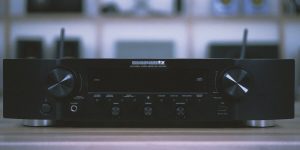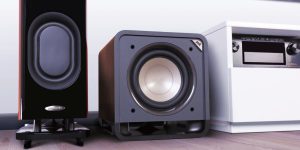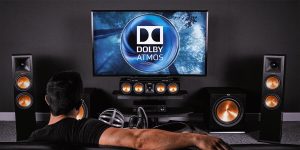Marantz’s “Cinema” product line is a set of unique models designed specifically for home theater and media rooms. These devices include only heavy-duty power amplification, audiophile-grade components, and state-of-the-art surround sound capabilities.
In my Marantz Cinema 40 review, I have tried to show the strengths of this model as objectively as possible, testing it and identifying its shortcomings. My analysis will help you decide whether this receiver is right for you or whether you should look for something else on the market.
Design

While highly capable on the inside, Marantz preserves its signature ergonomic and neat style on the outside. It retains the classic porthole display and symmetrical layout of control knobs and buttons Marantz is known for. The bottom section houses a cleverly hidden door that conceals most push-button controls when closed. Convenient? Undeniably.
The remote is a bit large for a modern control, though it is complete and well laid out.
The overall build quality is excellent, and it runs almost silently and does not get very hot (especially in Eco mode). I would also add that this AVR is a bit heavy at 33.3 pounds, which is another indication that it uses high-quality components and parts.
Features and specs

With robust discrete high-current amplifiers across all 9 channels, the Cinema 40 satisfies even power-hungry speaker configurations with 125W (8 ohms, 20 Hz – 20 kHz, 0.05% THD). There’s also an option of 11.4 channel processing. In addition, the Cinema 40 features advanced reference-class 32-bit/192kHz digital-to-analog converters on all channels.
Connectivity options are more than enough to set up a versatile home theater system. There are 7 in and 3 out HDMI, 2 composite, 5 analog, and 4 digital inputs. The HDMI offers upscaling 1080P/4K to 8K and also ARC/ eARC options. HDMI-CEC is buggy, but what isn’t? The entire AV industry is full of HDMI-CEC issues, so it’s not just Marantz. The video quality is promised to be exceptional, supporting HDR / HLG / Dolby Vision / HDR10+ / Dynamic HDR. In my opinion, the Cinema 40 provides a sharper video image with increased color saturation than the Cinema 60. This is my conclusion based on numerous tests and work with these two devices.
The Cinema 40 specifications of the system bring wireless streaming and smart integration into your A/V experience. You can use Bluetooth wireless transmission, whether streaming audio directly to the receiver or re-routing sound to Bluetooth headphones. Available WiFi and Ethernet network ports allow app and voice control flexibility via Amazon Alexa, Google Assistant, and Apple HomePod compatibility. The only oddity I experienced was to make Apple AirPlay work. As soon as I got it, AirPlay would connect, but there was no sound. Installing the HEOS app on my iPhone made AirPlay work fine. So this is what you should try if you have the same issue.
The unit can power up to 3 independent zones with various audio/video sources for whole-home distribution. Each zone draws content from the receiver’s abundant device connectivity.
This exhaustive support for all current 3D and channel-based surround formats allows the device to fully leverage the capabilities of premium speaker configurations. It truly unlocks full cinema immersion at home exactly according to its name. So here we have everything from DTS:X to Dolby Atmos, including various decoding and processing formats, as well as IMAX Enhanced, Auro-3D, 360 Reality Audio, and Multichannel Stereo2. Automatic selection between stereo and immersive formats is wonderful for experiencing the same sound.
My last remark concerns the only weird “quirk” it has. Sometimes, it makes a loud clunking when I power the unit on and off. Probably, it’s about the power supply. It doesn’t always happen, but it’s still a bit unpleasant when it happens.
Listening experience

Whether experiencing hushed dramatic dialogue or explosive action, the Marantz AV receiver delivered a realistic, engaging surround sound experience. Subtle textures in the tense spy action movie “Mission: Impossible – Dead Reckoning” came through with true-to-life clarity – the smash of glass and cracking of the train. Yet remarkably, such finer details never overwhelmed important character vocals.
As for music, the sound is also smooth, not muffled, providing a good soundstage. I think the sound improvement is more pronounced in multichannel mode (e.g., Dolby Atmos) than in stereo (e.g., turntable and CD), but vinyl on the Cinema 40 sounds great, too.
Key specs
- Channels: 9.4.
- Power output: 125W/8 Ohm, 165W/6 Ohm.
- HDMI inputs/outputs: 7/2.
- Video functions: 8K/60Hz, 4K/120Hz, 4K/60Hz pass-through, video upconversion (up to 1080p and 8K) for analog and HDMI sources.
- Bluetooth/Wi-Fi: yes/yes.
- Streaming services: AirPlay2, Deezer, Tidal, Pandora, Spotify, Amazon Music HD, TuneIn, SoundCloud, Mood Mix.
- Supports: HDMI ARC, HDMI eARC, HDR, HLG, Dolby Vision, HDR10+, Dynamic HDR, HDMI CEC.
- Surround sound: DTS HD Master, DTS:X, DTS Neural:X, DTS Virtual:X, Dolby TrueHD, Dolby Atmos, Dolby Atmos Height Virtualization, Dolby Atmos Music, Dolby Surround, IMAX Enhanced, Auro-3D, 360 Reality Audio, MPEG H, Audyssey DSX, Multichannel Stereo2.
We are supported by our audience. When you purchase through links on our site, we may earn an affiliate commission at no extra cost to you.
Our newsletter
* We will never send you spam or share your email with third parties

![Best Stereo Receivers [Reviewed and Tested]](https://mediapro-av.com/wp-content/uploads/2024/01/best-stereo-receiver-300x150.jpg)













